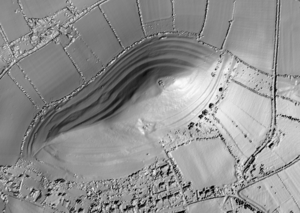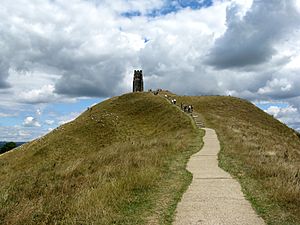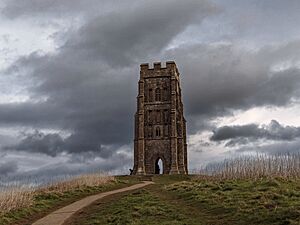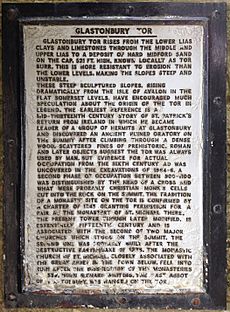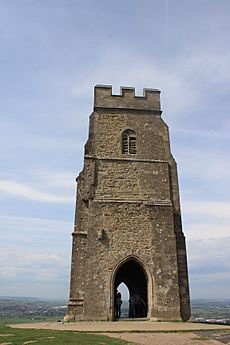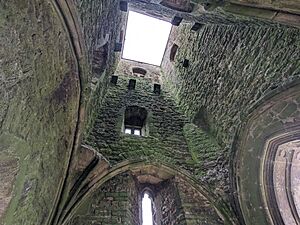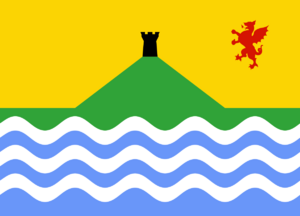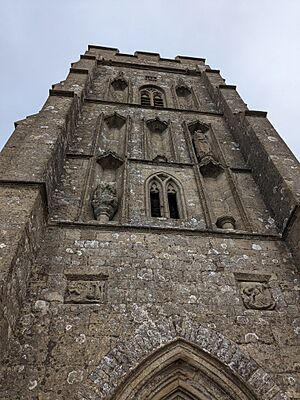Glastonbury Tor facts for kids
Quick facts for kids Glastonbury TorWelsh: Ynys Wydryn |
|
|---|---|
Glastonbury Tor in 2017
|
|
| Location | Glastonbury, Somerset, England |
| Governing body | National Trust |
| Official name: St Michael's Church, monastic remains, and other settlement remains on Glastonbury Tor | |
| Designated | 24 April 1954 |
| Reference no. | 1019390 |
|
Listed Building – Grade I
|
|
| Official name: St Michael's Church Tower | |
| Designated | 21 June 1950 |
| Reference no. | 1345475 |
| Lua error in Module:Location_map at line 420: attempt to index field 'wikibase' (a nil value). | |
Glastonbury Tor is a famous hill in Somerset, England. It's called a "tor" because it's a tall, rocky hill. At the very top, you'll find the remains of St Michael's Tower. This tower is a very old building, protected as a Grade I listed building.
The National Trust looks after the Tor. It's also a scheduled monument, which means it's an important historical site. The Tor is part of many old stories, especially those about King Arthur. It has a special meaning for many people.
This hill is made of clay and a type of rock called Blue Lias. It formed when softer ground around it wore away. This left the harder sandstone cap exposed. The sides of the Tor have flat, step-like areas called terraces. No one is quite sure how these terraces were made.
People have explored the Tor to learn more about its past. They found tools and pottery from the Iron Age and Roman times. This shows people visited the Tor long ago. Several buildings were built on the top during Saxon and early medieval times. These might have been an early church and homes for monks.
A cross from the 10th or 11th century was found here. The first wooden church was destroyed by an earthquake in 1275. A stone church, St Michael's, was built in the 14th century. Only its tower remains today, but it has been repaired many times.
| Top - 0-9 A B C D E F G H I J K L M N O P Q R S T U V W X Y Z |
What's in a Name? The Tor's History
Glastonbury and Tor Meanings
The name Glastonbury has a long history. In the late 600s and early 700s, it was called Glestingaburg. The first part, Glestinga, is a bit of a mystery. It might come from an old English word or a Celtic name. It could be linked to a person or family called Glast.
The second part, -burg, is an old English word. It could mean a strong, fortified place, like a castle. Or, it might mean an area where monks lived.
The word Tor means a bare, rocky hill with large stones. It comes from an old English word, torr. Some people think it's a Celtic word. But the closest Celtic word is Welsh for "tower."
The Celtic name for the Tor was Ynys Wydryn. This means 'Isle of Glass'. Long ago, the flat land around the Tor was often flooded. This made the Tor look like an island. At low tide, it became a peninsula.
Where is Glastonbury Tor?
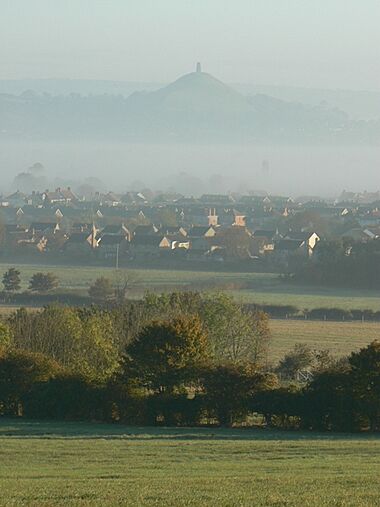
The Tor stands in the middle of the Summerland Meadows. These meadows are part of the Somerset Levels. The Tor rises to about 518 feet (158 meters) high. The land around it used to be a swamp. Now, it's reclaimed land, and the Tor can be seen from miles away.
People often call it an island. But it's actually at the end of a peninsula. The River Brue flows around three sides of it.
The Tor is made of rocks from the early Jurassic Period. The very top part is a strong sandstone. This sandstone acts like a hard cap. It protects the softer layers of rock below from wearing away.
The Red Water of Chalice Well
At the bottom of the Tor is a spring called Chalice Well. Its water is rich in iron. When this water comes to the surface, it mixes with oxygen. This makes the iron turn rusty and harden the sandstone around it. This process helps make the Tor's caprock even stronger.
Mirages and Magic: Fata Morgana
The low, damp ground around the Tor can create a special sight. It's called a Fata Morgana. This is a type of mirage. It makes the Tor look like it's floating out of the mist. This happens when light bends as it passes through air layers of different temperatures.
The name Fata Morgana comes from Morgan le Fay. She was a powerful sorceress in the legends of King Arthur.
Mysterious Terraces of the Tor
The sides of the Tor have seven deep, step-like terraces. How they were formed is still a mystery.
One idea is that they formed naturally. This could happen from different layers of rock and clay. Another idea is that farmers made them long ago. They might have used them to make it easier to grow crops. But this theory has problems. If they were for farming, you'd expect them to be mostly on the sunny side. But the terraces are just as deep on the shady side. Also, other hills nearby don't have these terraces.
Some people think the terraces were for defense. Many ancient hill forts had strong walls on their slopes. But the Tor's terraces don't look like typical defensive walls. They also don't leave much space on top for a community.
Another idea is that the terraces are part of a spiral path. This path might have been for pilgrims. They would walk around the terraces to reach the church at the top. This is similar to paths at other old sites like Whitby Abbey.
A more unusual idea is that the terraces form a giant labyrinth. A labyrinth is a maze-like pattern. This theory suggests that by walking the terraces, you follow a path to the top. If this is true, the terraces would be very old, from the Neolithic era. But it's hard to prove this idea. Farmers or monks might have changed the terraces over time.
A Look Back: History of Glastonbury Tor
Early Visitors to the Tor
People have visited Glastonbury Tor since ancient times. Stone tools from the Neolithic period have been found at the top. This shows that people were there thousands of years ago.
Nearby, the remains of Glastonbury Lake Village were found in 1892. This was an Iron Age settlement. It was built around 300–200 BC on what was then an island. There's no proof that people lived permanently on the Tor itself. But Roman pottery found there suggests it was visited often.
Between 1964 and 1966, archaeologists dug up parts of Glastonbury Tor. They found signs of people living there between the 5th and 7th centuries. They found holes where wooden posts stood, two fireplaces (one for a metalworker), and two burials. They also found pieces of old Mediterranean vases. These finds show that people were active on the Tor during this "Dark Ages" period.
Churches and Monks on the Summit
During the late Saxon and early medieval times, there were at least four buildings on the Tor's summit. A stone cross base shows that Christians used the site. It might have been a quiet place for monks to live. The broken top of a cross from the 10th or 11th century was found nearby. This cross head is now in the Museum of Somerset.
The first wooden church was likely built in the 11th or 12th century. It was named after St Michael. Holes in the ground show where its wooden posts stood. Homes for monks were also found nearby.
In 1243, King Henry III allowed a six-day fair to be held at the Tor.
On September 11, 1275, a strong earthquake destroyed St Michael's Church. The earthquake was felt in many parts of England and Wales. It caused a lot of damage to homes and churches.
A second church, also for St Michael, was built in the 14th century. It was made of local sandstone. This new church used the foundations of the old one. It had beautiful stained glass and decorated floor tiles. It's thought that the monastery on the Tor was connected to Glastonbury Abbey.
St Michael's Church stood until 1539. This was when King Henry VIII closed down many monasteries. The church, except for its tower, was torn down. The Tor became a place of execution. Richard Whiting, the last Abbot of Glastonbury Abbey, and two of his monks were executed there.
The three-story tower of St Michael's Church is what we see today. It has strong corner supports and openings for bells. There's also a carved stone tablet with an eagle below the top edge.
The Tor Today: Care and Conservation
In 1786, Richard Colt Hoare bought the Tor. He paid for repairs to the tower in 1804. Later, the Tor was sold and became part of the Butleigh Manor.
The last private owner, Robert Neville-Grenville, wanted to give the Tor to the National Trust. After he died in 1936, the National Trust bought it. They raised money from the public to help take care of it.
The National Trust took over the Tor in 1937. Repairs were put on hold until after World War II. In the 1960s, experts found cracks in the rock. This showed the ground had moved in the past. Wind also caused damage. The tower's foundations were repaired with concrete.
More and more visitors came to the Tor. Their footsteps started to damage the terraces. So, paths were built to help people reach the top without harming the hill. After the year 2000, more improvements were made. This included fixing the tower and rebuilding parts of its top. New stone from a quarry was used for these repairs.
Glastonbury Tor even appeared in the 2012 Summer Olympics opening ceremony in London. A model of the Tor, with a tree instead of the tower, was part of the show. As athletes entered, their flags were displayed on the model's terraces.
Myths and Magic: The Tor's Legends
The Tor was once called Ynys yr Afalon by the ancient Britons. Many people believe it is Avalon, the magical island from King Arthur's legends. Writers from the 12th and 13th centuries, like Gerald of Wales, linked the Tor to Avalon. This connection grew stronger after King Arthur's and Queen Guinevere's coffins were supposedly found in 1191. Some even think the Holy Grail might be hidden near the Tor.
In the 1800s, people became very interested in Celtic mythology again. The Tor then became linked to Gwyn ap Nudd. He was the first Lord of the Otherworld, a magical place. Later, he was known as the King of the Fairies. The Tor was seen as a doorway to this Otherworld or to Avalon, the land of fairies. It's even said to be a gateway to "The Land of the Dead."
A more recent story is about the Glastonbury Zodiac. This myth says that a giant astrological zodiac was carved into the land. It's supposedly made from old hedges and paths. In this zodiac, the Tor forms part of the Aquarius figure. This idea was first suggested in 1927 by Katherine Maltwood. She thought the zodiac was made about 5,000 years ago. But most of the land she described was underwater back then. Also, many of the features she pointed out, like field boundaries, are much more recent.
The Tor is also important to the modern Goddess movement. Every year, people celebrate this with a procession up the Tor. They carry a large figure of the Goddess.
It's said that a stone carving above one of the tower's entrances shows Brigid of Kildare milking a cow.
See also
 In Spanish: Glastonbury Tor para niños
In Spanish: Glastonbury Tor para niños
- List of hillforts and ancient settlements in Somerset
- List of National Trust properties in Somerset
- 1275 British earthquake



